|
This species has been introduced into California. It is not a native species.
|
It is unlawful to import, transport, or possess any Watersnakes of the genus Nerodia in
California except under permit issued by the California Department of Fish and Wildlife.
(California Code of Regulations, Title 14, Excerpts, Section 671)
The California Watersnakes Site reports on news, publications,
and
sightings related to non-native watersnake species (Nerodia) in California.
If you see a watersnake in the wild in California at a location not mentioned on the
California Watersnakes Site, please report it to California Nerodia Watch at iNaturalist.
(Don't confuse Watersnakes (Nerodia) with native California gartersnakes. Most gartersnakes
have stripes on the sides and sometimes on the back. Watersnakes have no stripes.)
|
 |
| Adult, Placer County |
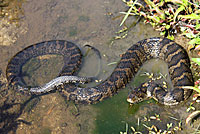 |
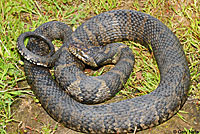 |
 |
| Adult, Placer County. |
Adult, Placer County. |
Adult, Placer County, with juvenile bullfrog in background |
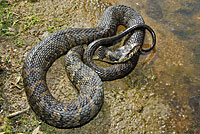 |
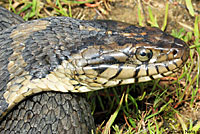 |
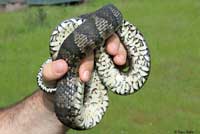 |
| |
Adult, Placer County. |
|
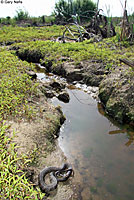 |
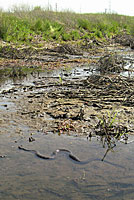 |
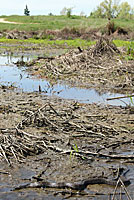 |
| |
Adult, Placer County. |
|
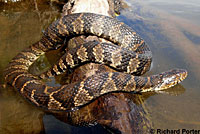 |
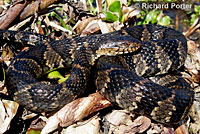 |
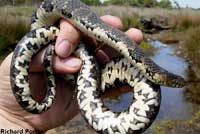 |
| Adult, Placer County. © Richard Porter |
 |
 |
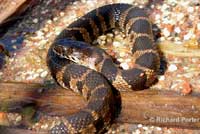 |
| Juvenile, Placer County. © Richard Porter |
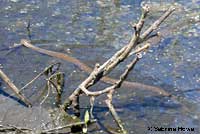 |
 |
|
| Adult, Placer County © Sabrina Howe |
|
| |
|
| Nerodia sipedon sipedon - Northern Watersnake - From Native Habitat Outside California |
 |
| Sub-adult, Fairfax County, Virginia |
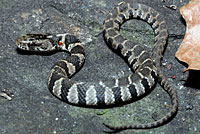 |
 |
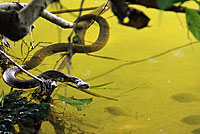 |
Juvenile, Lumpkin County, Georgia
|
Adult, Fairfax County, Virginia |
Adult, Fairfax County, Virginia |
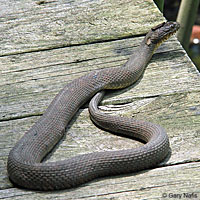 |
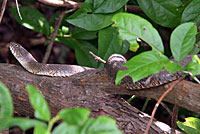 |
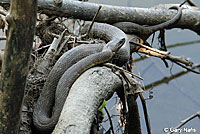 |
| Adult, Anne Arundel County, Maryland |
Adult, Anne Arundel County, Maryland |
Adult, Fairfax County, Virginia |
| |
|
|
| Habitat in California |
 |
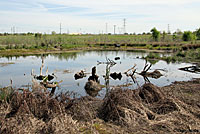 |
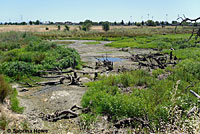 |
| Habitat, Placer County |
Habitat, Placer County |
Habitat, Placer County © Sabrina Howe |
| |
 |
|
| |
Habitat, Placer County © Sabrina Howe |
|
| |
|
|
| Short Videos |
 |
 |
|
| A large adult Northern Watersnake in Placer County crawls into the water. |
A large adult Northern Watersnake in Placer County in the water. |
|
|
|
|
| Description |
Not Dangerous - This snake does not have venom that can cause death or serious illness or injury in most humans.
Commonly described as "harmless" or "not poisonous" to indicate that its bite is not dangerous, but "not venomous" is more accurate. (A poisonous snake can hurt you if you eat it. A venomous snake can hurt you if it bites you.)
The saliva of this species contains a mild anticoagulant which can cause inflammation and more than usual bleeding, but this poses little risk to humans.
|
| Size |
From 12 - 42 inches (30 - 107 cm) up to 55 inches in length (140 cm).
|
| Appearance |
Dorsal and ventral patterns are variable.
Color can be brown, gray, brownish-black, or reddish, darkening with age.
Older adults are often all dark in color without any markings.
The head is typically one color and is gradually more rounded and more flat on top than the head of Nerodia fasciata.
The body is usually marked with dark blotches and dark cross-bands ring the neck.
The dorsal cross-bands on the rear of the snake change to "alternating middorsal and lateral blotches usually at or before midbody." *
The underside is white, yellow, or gray with crescent or half-moon-shaped markings that are dark and sometimes tan or yellowish in the center.
Spots may be in a double row or in a striped pattern.
|
| Behavior and Natural History |
Little is known of the natural history of this snake in California. In its natural habitat, they are active both day and night, and are usually seen in the morning or late afternoon when they are basking in sunny areas on stumps, rocks, logs, or vegetation next to water. Activity takes place from April to October in the northern part of its range, and earlier in the spring and later in the fall in the southern range. They hibernate during winter in burrows, crevices, or rock piles near or close to water, sometimes in den shared with other snake species.
This snake will bite and release excrement and musk when threatened or picked up. The saliva contains an anticoagulant which creates profuse bleeding in the victims of its bite. |
| Diet and Feeding |
Diet consists of small aquatic vertebrates such as fish, frogs, salamanders, small mammals, and even small birds, and invertebrates such as various kinds of worms, leeches, and crayfish. Snakes typically hunt for food along the edge of shallow water.
A captured Roseville snake regurgitated a non-native American Bullfrog and a native Pacific Chorus Frog (Sierran Treefrog), confirming that these introduced snakes are a threat to native wildlife. (Oliver J. Miano, Jonathan P. Rose, and Brian d. Todd, Herpetological Review 43(2), 2012)
|
| Reproduction |
In the natural range of this snake, mating occurs from April to June.
Females are ovoviviparous - they carry the eggs internally until the young are born live.
Females typically give birth to 15 - 30 live young between August and October in the northern part of its range and in July or August in the southern part of its range.
Breeding may not occur every year.
|
| Habitat |
This snake lives just about anywhere near fresh water - rivers, creeks, canals, lakes, ponds, oxbows, reservoirs, bogs swamps and marshes. It also inhabits brackish and saltwater habitats in some locations.
In Placer County, they have been found along the edge of a large freshwater marsh.
|
| Geographical Range |
This species is found throughout most of the United States east of the Mississippi River excluding parts of Maine, most of Florida and parts of the southeast coast, and west of the Mississippi through the central part of the country as far west as Colorado. It also occurs in southern Quebec and Ontario.
Introduced Populations in California
In California Common Watersnakes have been established in Roseville in Placer County.
(Peter S. Balfour, Dustin Broen, Eric W. Stitt, Kenra Grinsell, and Allison K. Buchanan. Herpetological Review 38(4), 2007)
In May, 2011, a Common Watersnake was captured by fishermen in and irrigation canal in the central valley near Manteca in San Juoquin County. Attempts to locate other watersnakes at the location were unsuccessful. This find was troubling because it is within the historic range of the Giant Gartersnake, a threatened species that could be in greater danger should the watersnakes spread into their range.
|
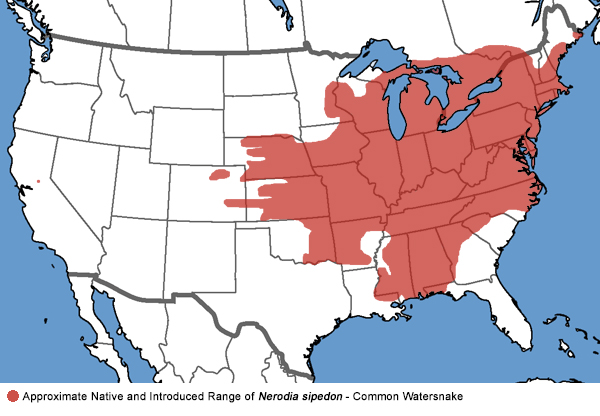 |
| Notes on Taxonomy |
There are four subspecies of Nerodia sipedon in the United States:
N. s. insularum - Lake Erie Watersnake
N. s. pleuralis - Midland Watersnake
N. s. sipedon - Common Watersnake
N. s. williamengelsi - Carolina Watersnake
It is not known which subspecies has become established in California, but it is most likely N. s. sipedon.
Alternate and Previous Names (Synonyms)
Nerodia sipedon sipedon - Northern Water Snake (Conant & Collins 1998, Powell, Conant & Collins 2016)
Nerodia sipedon sipedon - Northern Water Snake (Stebbins 1985, 2003)
Natrix sipedon - Common Water Snake (Stebbins 1954, 1966)
Natrix sipedon sipedon - Water snake (Linne 1758)
Common water snake (Macauley 1829)
Banded water snake (Hurter 1893)
Black water adder
Black (water) snake
Brown water snake
Common northern water snake
Eastern water snake
Moccasin water snake
Mud moccasin
Northern American water snake
Northern banded water snake
Northern water snake
Spotted water adder
Spotted water snake
Streaked snake
Washington water snake
Water adder
Water pilot
Water viper
|
| Conservation Issues (Conservation Status) |
Spread of this snake downstream into the Sacramento Valley could possibly threaten populations of the already endangered Giant Gartersnake, Thamnophis gigas. It could also pose a threat to other native fish and wildlife.
As of January 2008 it is unlawful to import, transport, or possess any Watersnakes of the genus Nerodia in California except under permit issued by the California Department of Fish and Wildlife.
(California Code of Regulations, Title 14, Excerpts, Section 671)
See: California Department of Fish and Game Restricted Species Regulations
|
|
|
Taxonomy |
| Family |
Colubridae |
Colubrids |
Oppel, 1811 |
| Genus |
Nerodia |
American Watersnakes |
Baird and Girard, 1853 |
Species
|
sipedon |
Common Watersnake |
(Linnaeus, 1758) |
|
Original Description |
sipedon, Nerodia Serpentes
Nerodia sipedon (Linnaeus, 1758) - Syst. Nat., 10th ed., Vol. 1, p. 219
from Original Description Citations for the Reptiles and Amphibians of North America © Ellin Beltz
|
|
Meaning of the Scientific Name |
Nerodia - Greek - nereis = name of a sea nymph
sipedon - Greek - sepedon = rottenness, decay; a serpent whose bite causes mortification
from Scientific and Common Names of the Reptiles and Amphibians of North America - Explained © Ellin Beltz
|
|
Related or Similar California Herps |
Thamnophis sirtalis fitchi - Valley Gartersnake
Thamnophis gigas - Giant Gartersnake
Nerodia fasciata pictiventris - Florida Water Snake
|
|
More Information and References |
California Nerodia - a website about introduced populations of Nerodia found in California.
California Department of Fish and Wildlife
Peter S. Balfour, Dustin Broen, Eric W. Stitt, Kenra Grinsell, and Allison K. Buchanan. Herpetological Review 38(4), 2007
* Gibbons, J. Whitfield, Michael E. Dorcas. North American Watersnakes - A Natural History. University of Oklahoma Press. 2004.
Robert Powell, Roger Conant, and Joseph T. Collins. Peterson Field Guide to Reptiles and Amphibians of Eastern and Central North America. Fourth Edition. Houghton Mifflin Harcourt, 2016.
Conant, Roger, and Joseph T. Collins. A Field Guide to Reptiles and Amphibians Eastern and Central North America.
Third Edition, Houghton Mifflin Company, 1998.
Bartlett, R.D., & Alan Tennant. Snakes of North America - Eastern and Central Regions. Gulf Publishing Co., 2000.
|
|
|
The following conservation status listings for this animal are taken from the July 2025 State of California Special Animals List and the July 2025 Federally Listed Endangered and Threatened Animals of California list (unless indicated otherwise below.) Both lists are produced by multiple agencies every year, and sometimes more than once per year, so the conservation status listing information found below might not be from the most recent lists, but they don't change a great deal from year to year.. To make sure you are seeing the most recent listings, go to this California Department of Fish and Wildlife web page where you can search for and download both lists:
https://www.wildlife.ca.gov/Data/CNDDB/Plants-and-Animals.
A detailed explanation of the meaning of the status listing symbols can be found at the beginning of the two lists. For quick reference, I have included them on my Special Status Information page.
If no status is listed here, the animal is not included on either list. This most likely indicates that there are no serious conservation concerns for the animal. To find out more about an animal's status you can also go to the NatureServe and IUCN websites to check their rankings.
Check the current California Department of Fish and Wildlife sport fishing regulations to find out if this animal can be legally pursued and handled or collected with possession of a current fishing license. You can also look at the summary of the sport fishing regulations as they apply only to reptiles and amphibians that has been made for this website.
It is against the law to capture, move, possess, collect, or distribute this invasive species.
See: California Department of Fish and Game Restricted Species Regulations
|
| Organization |
Status Listing |
Notes |
| NatureServe Global Ranking |
|
|
| NatureServe State Ranking |
|
|
| U.S. Endangered Species Act (ESA) |
None |
|
| California Endangered Species Act (CESA) |
None |
|
| California Department of Fish and Wildlife |
None |
|
| Bureau of Land Management |
None |
|
| USDA Forest Service |
None |
|
| IUCN |
|
|
|
|
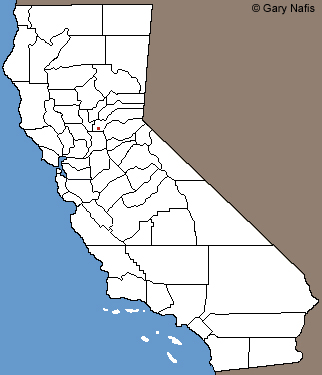 Red: Location of non-native populations in California
Red: Location of non-native populations in California
































